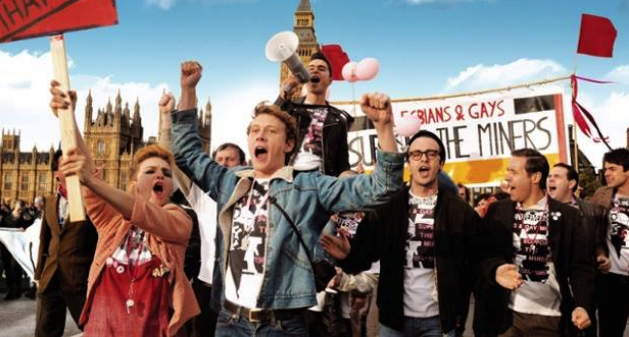What is “Pride” all about?
The film follows a group of LGBTQ+ activists who come together to support a Welsh mining community during the UK miners’ strike in 1984.
The group, which calls itself “Lesbians and Gays Support the Miners” (LGSM), initially struggles to find a group of miners who are willing to accept their support. However, they eventually make contact with a small mining village in Wales and begin fundraising to support the miners and their families.
As the relationship between LGSM and the miners develops, both groups begin to understand and appreciate each other’s struggles. The film explores issues of class, identity, and the power of solidarity, as LGSM and the miners work together to fight for their rights.
“Pride” was critically acclaimed upon its release, and was praised for its mix of humor and drama, as well as its positive portrayal of LGBTQ+ characters. The film was also seen as a tribute to the real-life activists who inspired it, and to the power of grassroots activism to effect change.
Did the film “Pride” get good reviews?
Yes, “Pride” received very positive reviews from critics upon its release in 2014. The film has a 93% approval rating on Rotten Tomatoes, based on 169 reviews, with an average rating of 8.0/10. The site’s critical consensus describes the film as “earnest, well-acted, and overall inspirational,” and notes that it “avoids easy clichés and formula.”
Many reviewers praised the film’s mix of humor and drama, as well as its strong ensemble cast. The performances of actors such as Bill Nighy, Imelda Staunton, and Andrew Scott were particularly singled out for praise.
“Pride” was also praised for its positive portrayal of LGBTQ+ characters, and for its exploration of issues of class, identity, and the power of solidarity. Many critics saw the film as a tribute to the real-life activists who inspired it, and as a reminder of the importance of grassroots activism in effecting change.
Overall, “Pride” was widely regarded as a well-crafted and inspiring film that blended comedy and drama, and celebrated the power of community and activism.
Is the film “Pride” based on a true story?
“Pride” is based on a true story. The film depicts the real-life events of the summer of 1984, when a group of lesbian and gay activists formed the group Lesbians and Gays Support the Miners (LGSM) and began raising money to support the striking miners and their families.
The LGSM group consisted of around 20 activists from London, who decided to support the striking miners after recognizing that both groups were fighting for their rights and for a fairer society. The group raised thousands of pounds for the miners, and their efforts were warmly received by some of the mining communities they supported.
The film’s portrayal of the LGSM’s involvement in the miners’ strike is largely accurate, although some elements have been fictionalized for dramatic effect. The film’s characters are also composites of several real-life activists, rather than being based on specific individuals.
Overall, while “Pride” takes some artistic license with the story, it is based on a real and inspiring episode in British history that saw two marginalized groups coming together in solidarity to fight for their rights.
How much did the film Pride make?

According to Box Office Mojo, the film “Pride” grossed approximately $16.4 million worldwide during its theatrical release in 2014.
While this may not seem like a huge amount compared to some Hollywood blockbusters, “Pride” was actually a considerable success for an independent British film. It was made on a relatively modest budget of around £3.3 million, and its strong critical reception and positive word-of-mouth helped to generate a loyal fanbase.
“Pride” was also well-received at various film festivals, winning the Queer Palm award at the Cannes Film Festival and the People’s Choice Award at the Toronto International Film Festival.
Beyond its box office success, “Pride” has also had a lasting cultural impact. The film has been praised for its positive portrayal of LGBTQ+ characters, and for its celebration of the power of solidarity and grassroots activism. It has also helped to raise awareness of the real-life events that inspired it, and has been credited with helping to cement the legacy of the LGSM group and their efforts to support the striking miners.

